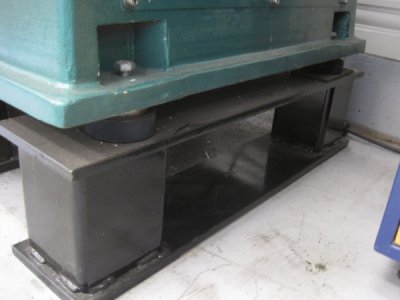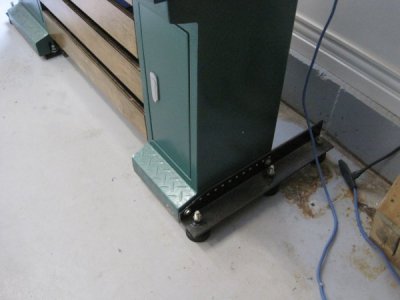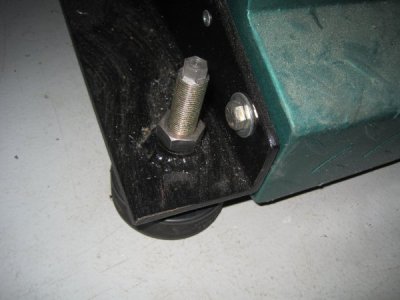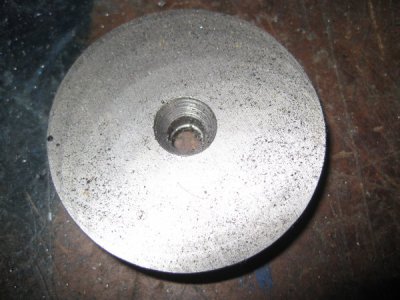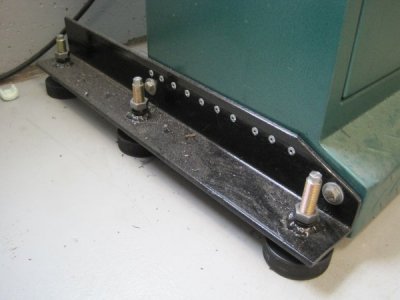-
Welcome back Guest! Did you know you can mentor other members here at H-M? If not, please check out our Relaunch of Hobby Machinist Mentoring Program!
You are using an out of date browser. It may not display this or other websites correctly.
You should upgrade or use an alternative browser.
You should upgrade or use an alternative browser.
Elevated mill
- Thread starter dpb
- Start date
There seems to be disagreement about that. There's a PM thread were some like anti vibration pads and some hate them. Joe Pie commented in one of his videos that he had them on his lathe and that he gets a better finish because of it.
I didn't want to drill in my garage floor and wanted to widen the mills stance in case I swung the ram way out or did something stupid that might cause it to tilt over. So vibration was not my reason for doing it, although I thought it might be a poor man's version or anti vibration feet.
I haven't noticed any negative effects although there may be and I haven't noticed them yet.
I didn't want to drill in my garage floor and wanted to widen the mills stance in case I swung the ram way out or did something stupid that might cause it to tilt over. So vibration was not my reason for doing it, although I thought it might be a poor man's version or anti vibration feet.
I haven't noticed any negative effects although there may be and I haven't noticed them yet.
- Joined
- Jan 20, 2018
- Messages
- 5,638
A mill is a rigid, monolithic casting and is not sensitive to level and stability like a lathe. It is a good idea to make it level in order to be able to use a level for certain set-ups, and it's definitely nice if it doesn't rock, but neither of these will affect the accuracy or repeatability.
Last edited:
- Joined
- Apr 29, 2019
- Messages
- 2,063
The factory where I work is near a RR track, when the big coal train goes by with 150 identical max load cars it gets the whole shop rocking and rolling. None of the machines in the shop can hold a tight tolerance while a train is going by.
A lathe does not need to be level, it does need to be straight. It is just that level is the easiest way to measure straight, and as you mentioned, there are some setups that will benefit from having the machine as close to perfect level as you can get it.
A lathe does not need to be level, it does need to be straight. It is just that level is the easiest way to measure straight, and as you mentioned, there are some setups that will benefit from having the machine as close to perfect level as you can get it.
There seems to be disagreement about that. There's a PM thread were some like anti vibration pads and some hate them. Joe Pie commented in one of his videos that he had them on his lathe and that he gets a better finish because of it.
I didn't want to drill in my garage floor and wanted to widen the mills stance in case I swung the ram way out or did something stupid that might cause it to tilt over. So vibration was not my reason for doing it, although I thought it might be a poor man's version or anti vibration feet.
I haven't noticed any negative effects although there may be and I haven't noticed them yet.
Apologies for digging up this old thread, but I happened to be watching the Joe Pie video where he mentions the anti vibration pads on his lathe. I linked to where he talks about them. He likes them and he's a very credible machinist.
- Joined
- Feb 1, 2015
- Messages
- 9,621
I trust that you a referring to a knee mill. The smaller mills and mill/drills are neither rigid nor stable.A mill is a rigid, monolithic casting and is not sensitive to level and stability like a lathe. It is a good idea to make it level in order to be able to use a level for certain set-ups, and it's definitely nice if it doesn't rock, but neither of these will affect the accuracy or repeatability.
Raised mine - much more comfortable.
Adjustable leveling feet sitting on hockey pucks.
Hockey pucks sounds like a great idea. I may give that a go on my lathe.
- Joined
- Apr 24, 2013
- Messages
- 709
Hockey pucks sounds like a great idea. I may give that a go on my lathe.
I used threaded rod with a pair of lock nuts for adjustment.
The rod was turned with a 60 degree point and fitted to disks about 2 inches by 3/8 inch thick.
The steel disks then sit on the hockey pucks.
Used the same system for the lathe and both have worked fine and very stable. Haven't had to adjust the level since they were put in.


